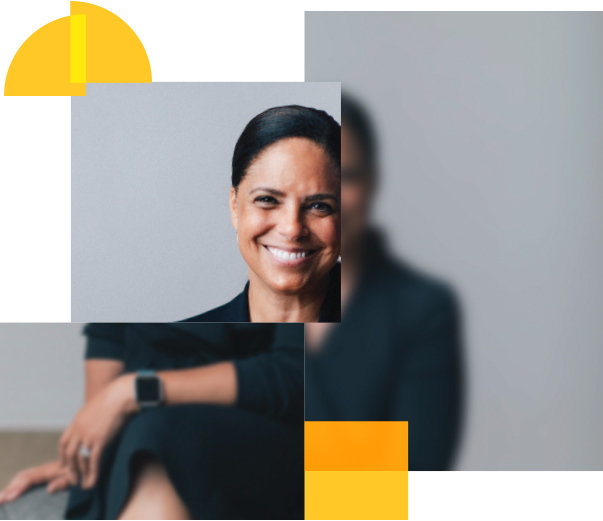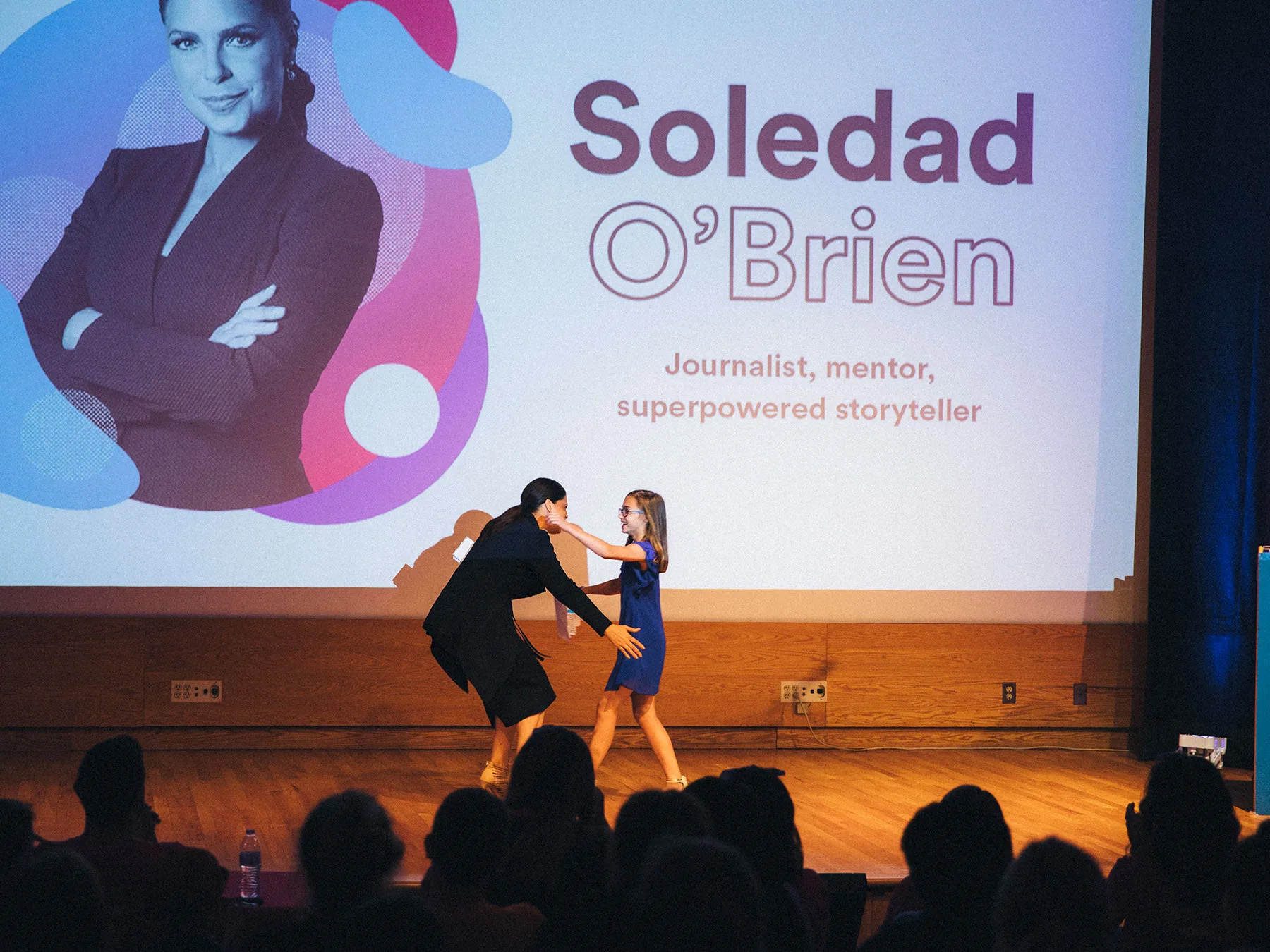Soledad O’Brien is biased (and so are you)

If you were to stop reading right now, you’d walk away with a warped image of Soledad O’Brien.
That’s because while the title of this article is true, it’s only part of the story. As a journalist, Soledad O’Brien aims to educate the public and start a conversation, but titles or headlines like the one above can have the opposite effect. They’re inflammatory without offering real information, and can just as easily alienate those who don’t share the same opinion as play into confirmation bias for those who do.
As Soledad explained at EF’s 2019 Global Leadership Summit in New York, she goes for facts over froth in her reporting. She digs into the nuanced, challenging details. And, when appropriate, she frames her subjects the way they’d want to be seen. Why? Because she believes it’s far too easy to tear down the voiceless when they’re not the ones telling their stories.
So while Soledad is far from voiceless, let’s give her the introduction she deserves.
You can’t sum up Soledad O’Brien in a sentence
Let’s start with why she’s a household name: Soledad O’Brien is an Emmy Award-winning journalist and the CEO of Starfish Media Group. She’s reported everywhere from CNN to PBS, making diverse topics such as race relations and humanitarian disasters accessible to all.
She’s also a mother. The daughter of two educators. An avid traveler. An equestrian. A warm, confident, three-dimensional human who bristles when fellow journalists employ easily misconstrued headlines. And she’s biased. But that’s okay.
You could say Soledad’s first experience with bias occurred before she was even born. Her parents, a black woman from Cuba and a white man from Australia, got married in 1958 when interracial marriage was still illegal in their home state of Maryland. And despite friends warning them not to have children—because, as Soledad quotes, “biracial children would not fit in this world”—they went on to have six.
Soledad’s parents taught her to be proud of her dual identity. They taught her that not only did she belong, but she had just as much of a right to share her story as anyone else. These lessons have influenced her whole career, inspiring her to give even more people a voice.
Bias is not inherently terrible. Its just a reality. What's terrible is when you know you have a bias and you don't do anything about it
Soledad O'Brien
Lean into the awkwardness
Bias is a tricky topic to approach, but that doesn’t scare Soledad. “I feel like I have my Ph.D. in uncomfortable topics,” she jokes. When it comes to bias, she believes the first step is recognizing it exists. Sure, that can lead to uneasy conversations—but pushing through the awkwardness is the only way to overcome it. “Bias is not inherently terrible,” she explains. “It’s just a reality. What’s terrible is when you know you have a bias and you don’t do anything about it.”
Soledad is quick to point out her own biases, too. “I have a ton,” she admits. For one, “I have a bias for people who are like me,” a tendency that became clear when she was hiring for her media company. However, once she identified her bias, largely through conversation with her husband, Soledad sought out a way to counterbalance it. How? By building a hiring team to generate fairer conversations around each candidate.
Soledad also warns of the dangers of confirmation bias, where people consciously or unconsciously seek out or interpret information in a way that affirms their own beliefs. Especially in this digital age, she says, “We can completely self-select what kind of information and content we want.” That’s great for staying within comfort zones, but not so great when trying to search for a more objective truth.
Confirmation bias often manifests itself online, where partisan news sources and social media algorithms can keep people in an echo chamber. But it also comes into play during in-person interactions. “We want to be embraced by people,” Soledad says, which means we tend to favor and surround ourselves with others who support our personal views.
“If you were in a room where I paid half the people to nod and clap as you spoke, and the other half to scowl at you, I guarantee you would prefer the side that was giving you positive feedback,” she explains. “Even if I asked you why you liked them more, you might not consciously be able to articulate it—but it would be because they sent you signals that they agreed with you.”
In other words, it’s easy to fall victim to biases without realizing it. But that doesn’t let anyone off the hook. Instead, it increases our responsibility to reflect on our own views. To search for our implicit biases, acknowledge them, and find ways to move past them. Even if it gets a little awkward.
Seek out the stories that aren’t being told
Once we discover our own biases, then what? Our beliefs can only expand to fit what we know—or think we know—based on our preconceived notions. So to broaden those beliefs, we need to expand the information we take in.
“It’s not just that everybody has a story, which we do,” Soledad says. “It’s that those stories are important and deserve to be told.” That’s why she has been deliberate about using her platform to elevate voices that aren’t usually heard. Soledad has highlighted soybean farmers in the Midwest. She’s followed the lives of African Americans living in the U.S. through her documentary series “Black in America.” She’s given the microphone to families of missing Native American women, raising awareness of a national crisis that’s been largely ignored.
Back in 2011, she realized none of the media’s stories during the aftermath of September 11 featured female rescue workers. “When you looked back at the record, even when you looked at the artwork,” she says, “women [rescue workers] didn’t exist.” So Soledad did something about it. In her CNN documentary “Beyond Bravery: The Women of 9/11,” she highlighted six of these heroes, including law enforcement officers, firefighters, and EMS workers.
Her documentary shared their experiences from 9/11, as well as the effects that day continued to have on them in the years that followed. She gave these women the visibility they deserved and the opportunity to tell the stories they had every right to share.
Finding new voices is part of Soledad’s job, but you don’t have to be a media professional to do your part. In fact, one of the simplest and most accessible ways Soledad seeks out new perspectives is by expanding the points of view she listens to on social media. “I follow anybody who has an interesting voice on Twitter, because that allows you to have conversations you wouldn’t be part of otherwise.”
You can also read books by a diverse set of authors, explore museums that delve into different cultures, or—to fully immerse yourself in a new way of life—travel. Sure, we’re biased here at EF, but (literally) stepping outside of your comfort zone is one of the best ways to meet people and open yourself up to new perspectives. As Soledad puts it, “That’s the whole point of travel: to see how other people live and think.”

“I was going to tell Glorious’ story. I owed it to her to tell it the right way.”
Read (and write) responsibly
There’s no such thing as a completely neutral source. Authors, journalists, people on social media—even educators—bring their own implicit biases to every story they tell and idea they convey. Underlying views can be expressed through something as obvious as incendiary diction, or as subtle as a slightly-less-than-enthusiastic tone.
That’s why Soledad encourages storytellers to be conscious of the ways their biases might slip through. For example, while working on “Black in America” and documenting the life of high-schooler Glorious Menefee, Soledad realized there were two ways she could tell Glorious’ story. She could begin with the negative, discussing the difficult issues surrounding the teenager’s family life and neighborhood. Or she could begin by framing Glorious in a positive light, explaining that she was a good student, a peer mentor, and a starter on the lacrosse team.
In the end, the documentary told Glorious’ full story—the good and the bad—but it began by framing her positively. Soledad had to argue with her producer to secure that introduction, but, as she explains, “I was going to tell Glorious’ story. I owed it to her to tell it the right way.”
On the other hand, we’re not always in the position to be storytellers. More often, we’re story consumers—and we can’t rely on all sources to be as vigilant as Soledad when it comes to checking their biases. That requires us to read, watch, and listen with intention, and not immediately accept stories and ideas at face value. It’s important to consider the perspective of the person telling the story, and to try to recognize how their own biases might impact the information we’re receiving.
No matter what side of the story we’re on, we all share the same responsibility. If you’re reading a story, read it critically. And if you’re given the privilege of sharing somebody else’s, follow Soledad’s lead and make sure you do them justice.

Keep the conversation going
We can’t solve for bias. The very idea of a “solution” is unrealistic, given its nature. However, we can find ways to navigate it. And, as Soledad knows from her 30+ years as a communications professional, the best way to do that is to get people talking. Lots of people. Including you and your students.
So keep searching for new information. Keep seeking out new voices. Let the introduction of viewpoints different from your own spur you to listen harder and think deeper, rather than stop the conversation altogether. Push yourself to reflect on your own biases and look for ways to surpass them. Bias will always be there. But, as Soledad reminds us, “You just have to challenge it and strategize a way around it.”
The conversation can’t stop here, but we’ll leave you with this: Get comfortable with the fact that you’ll never have all the information—and let that fact inspire you to keep digging. Because the more you listen and the more you share, the closer we’ll all get to something resembling the truth.
Bias in the classroom
Learn how fellow teachers help their students recognize bias—and how they keep their own in check
Related articles

This world is what students make of it
Explore with us at this year's Global Leadership Summits
Browse tours


